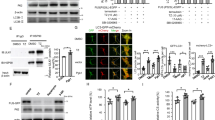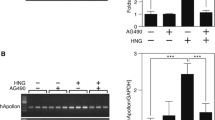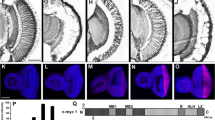Abstract
Dentatorubral-pallidoluysian atrophy (DRPLA) is an autosomal-dominant neurodegenerative disorder caused by expansion of CAG repeats in the DRPLA gene, which codes for a polyglutamine (polyQ) stretch. The expanded polyQs are known to form intracellular aggregates and to confer neurotoxic activity. Recent studies have indicated that activation of apoptosis signal-regulating kinase 1 (ASK1) is involved in polyQ-induced apoptosis. Humanin (HN) is an endogenous peptide that inhibits neuronal cell death caused by mutant Alzheimer’s disease genes, and this neuroprotective factor has recently been reported to suppress apoptosis by inhibiting activation of ASK1. To test the anti-ASK1 effect of HN on polyQ neurotoxicity, we constructed neuronal PC12 cells expressing expanded polyQs under the control of the Tet-Off™ system. Using this cell line, we showed that HN suppresses apoptotic cell death induced by expanded polyQs. However, the suppression was incomplete, suggesting that polyQs also stimulate other pathogenic cascades unrelated to ASK1. We further showed that HN suppresses polyQ aggregate formation. This result implied the possibility that aggregation is also related to the polyQ-mediated cascade involving ASK1 activation. Although the details remain uncertain, our results suggest that ASK1 is potentially involved in pathogenesis of DRPLA and that HN might contribute partially to the suppression of neurodegeneration in polyQ diseases.
Similar content being viewed by others
References
Bence N. F., Sampat R. M., and Kopito R. R. (2001) Impairment of the ubiquitin-proteasome system by protein aggregation. Science 292, 1552–1555.
Chai Y., Koppenhafer S. L., Bonini N. M., et al. (1999) Analysis of the role of heat shock protein (Hsp) molecular chaperones in polyglutamine disease. J. Neurosci. 19, 10,338–10,347.
Guo B., Zhai D., Cabezas E., et al. (2003) Humanin peptide suppresses apoptosis by interfering with Bax activation. Nature 423, 456–461.
Hashimoto Y., Niikura T., Chiba T., et al. (2003) The cytoplasmic domain of Alzheimer’s amyloid-beta protein precursor causes sustained apoptosis signal-regulating kinase 1/c-Jun NH2-terminal kinase-mediated neurotoxic signal via dimerization. J. Pharmacol. Exp. Ther. 306, 889–902.
Hashimoto Y., Niikura T., Tajima H., et al. (2001) A rescue factor abolishing neuronal cell death by a wide spectrum of familial Alzheimer’s disease genes and Abeta. Proc. Natl. Acad. Sci. U. S. A. 98, 6336–6341.
Igarashi S., Koide R., Shimohata T., et al. (1998) Suppression of aggregate formation and apoptosis by transglutaminase inhibitors in cells expressing truncated DRPLA protein with an expanded polyglutamine stretch. Nat. Genet. 18, 111–117.
Kariya S., Hirano M., Furiya Y., et al. (2004) Effect of humanin on ATP production: a therapeutic candidate for mitochondrial disorders. Ann. Neurol. 56, s65.
Kariya S., Takahashi N., Hirano M., et al. (2003) Humanin improves impaired metabolic activity and prolongs survival of serum-deprived human lymphocytes. Mol. Cell. Biochem. 254, 83–89.
Kariya S., Takahashi N., Ooba N., et al. (2002) Humanin inhibits cell death of serum-deprived PC12h cells. Neuroreport 13, 903–907.
Kaufman R. J. (1999) Stress signaling from the lumen of the endoplasmic reticulum: coordination of gene transcriptional and translational controls. Genes Dev. 13, 1211–1233.
Kim M., Lee H. S., LaForet G., et al. (1999) Mutant huntingtin expression in clonal striatal cells: dissociation of inclusion formation and neuronal survival by caspase inhibition. J. Neurosci. 19, 964–973.
Koide R., Ikeuchi T., Onodera O., et al. (1994) Unstable expansion of CAG repeat in hereditary dentatorubral-pallidoluysian atrophy (DRPLA). Nat. Genet. 6, 9–13.
Kouroku Y., Fujita E., Jimbo A., et al. (2002) Polyglutamine aggregates stimulate ER stress signals and caspase-12 activation. Hum. Mol. Genet. 11, 1505–1515.
Kuemmerle S., Gutekunst C. A., Klein A. M., et al. (1999) Huntington aggregates may not predict neuronal death in Huntington’s disease. Ann. Neurol. 46, 842–849.
Lin X., Cummings C. J., and Zoghbi H. Y. (1999) Expanding our understanding of polyglutamine diseases through mouse models. Neuron 24, 499–502.
Martindale D., Hackam A., Wieczorek A., et al. (1998) Length of huntingtin and its polyglutamine tract influences localization and frequency of intracellular aggregates. Nat. Genet. 18, 150–154.
Matsuzawa A., Nishitoh H., Tobiume K., et al. (2002) Physiological roles of ASK1-mediated signal transduction in oxidative stress- and endoplasmic reticulum stress-induced apoptosis: advanced findings from ASK1 knockout mice. Antioxid. Redox Signal. 4, 415–425.
Moulder K. L., Onodera O., Burke J. R., et al. (1999) Generation of neuronal intranuclear inclusions by polyglutamine-GFP: analysis of inclusion clearance and toxicity as a function of polyglutamine length. J. Neurosci. 19, 705–715.
Nagai Y., Tucker T., Ren H., et al. (2000) Inhibition of polyglutamine protein aggregation and cell death by novel peptides identified by phage display screening. J. Biol. Chem. 275, 10,437–10,442.
Nishitoh H., Matsuzawa A., Tobiume K., et al. (2002) ASK1 is essential for endoplasmic reticulum stress-induced neuronal cell death triggered by expanded polyglutamine repeats. Genes Dev. 16, 1345–1355.
Nucifora F. C. Jr., Sasaki M., Peters M. F., et al. (2001) Interference by huntingtin and atrophin-1 with cbp-mediated transcription leading to cellular toxicity. Science 291, 2423–2428.
Paulson H. L., Bonini N. M., and Roth K. A. (2000) Polyglutamine disease and neuronal cell death. Proc. Natl. Acad. Sci. U. S. A. 97, 12,957–12,958.
Popiel H. A., Nagai Y., Onodera O., et al. (2004) Disruption of the toxic conformation of the expanded polyglutamine stretch leads to suppression of aggregate formation and cytotoxicity. Biochem. Biophys. Res. Commun. 317, 1200–1206.
Saudou F., Finkbeiner S., Devys D., et al. (1998) Huntingtin acts in the nucleus to induce apoptosis but death does not correlate with the formation of intranuclear inclusions. Cell 95, 55–66.
Takano T., Yamanouchi Y., Nagafuchi S., et al. (1996) Assignment of the dentatorubral and pallidoluysian atrophy (DRPLA) gene to 12p 13.31 by fluorescence in situ hybridization. Genomics 32, 171–172.
Waelter S., Boeddrich A., Lurz R., et al. (2001) Accumulation of mutant huntingtin fragments in aggresome-like inclusion bodies as a result of insufficient protein degradation. Mol. Biol. Cell 12, 1393–1407.
Author information
Authors and Affiliations
Corresponding author
Rights and permissions
About this article
Cite this article
Kariya, S., Hirano, M., Nagai, Y. et al. Humanin attenuates apoptosis induced by DRPLA proteins with expanded polyglutamine stretches. J Mol Neurosci 25, 165–169 (2005). https://doi.org/10.1385/JMN:25:2:165
Received:
Accepted:
Issue Date:
DOI: https://doi.org/10.1385/JMN:25:2:165




